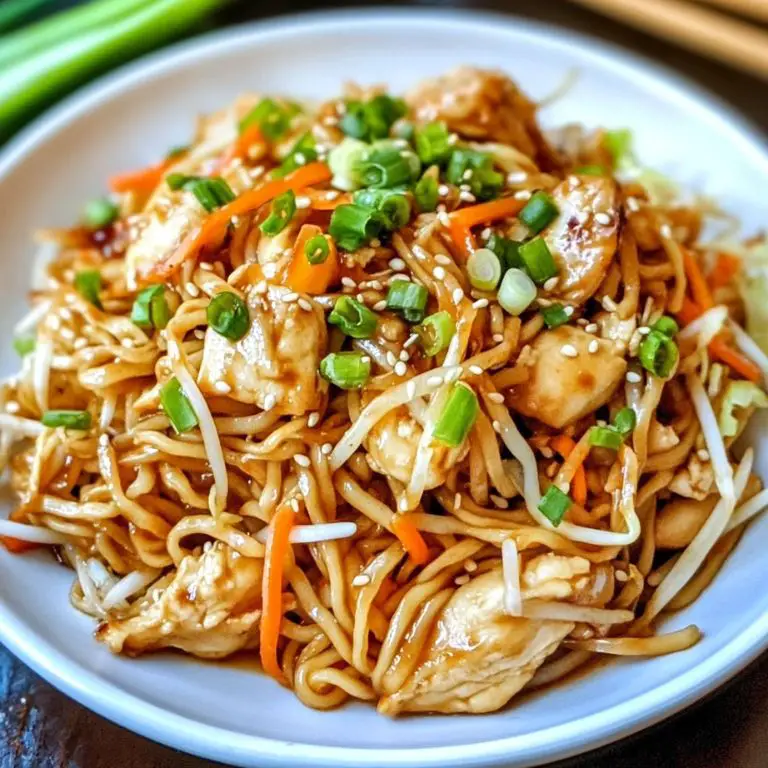
Yakitori, ramen, sushi—Japanese cuisine is packed with amazing flavors, but one dish that never fails to satisfy is yakisoba. This savory, slightly sweet, and smoky stir-fried noodle dish is loaded with tender chicken, crispy vegetables, and a tangy sauce that keeps you coming back for more. Whether you're recreating street food flavors at home or just looking for a quick weeknight dinner, this Classic Chicken Yakisoba will hit the spot.
One of the most important components of yakisoba is, unsurprisingly, the noodles. Traditional yakisoba noodles are made from wheat flour and are similar in texture to ramen but are often steamed rather than fried. You’ll find these noodles pre-cooked in vacuum-sealed packages in many Asian grocery stores.
If you can’t find authentic yakisoba noodles, there are a few acceptable substitutes:
To prepare pre-cooked yakisoba noodles, rinse them briefly under warm water and separate them gently with your fingers. Avoid boiling them unless instructed, as overcooking can lead to mushy texture. For dry noodles, cook them just until soft and rinse under cold water to halt cooking before stir-frying.
Stir-frying yakisoba is all about timing, heat control, and order of operations. Here are a few pro tips to help you nail the perfect stir-fry:
If your noodles start sticking, add a splash of water or mirin and keep the heat high. And remember: overloading the wok can result in steaming instead of searing—cook in batches if needed.
Chicken Yakisoba pairs beautifully with a refreshing side like Japanese cucumber salad (sunomono) or a simple bowl of miso soup. If you're looking for a drink, a cold Asahi beer or a cup of green tea complements the dish perfectly.
Chicken yakisoba isn’t just a hit with adults—it’s also a great way to introduce kids to new flavors in a familiar format. The colorful veggies, tender chicken, and sweet-savory sauce are often a welcome change from the usual dinner rotation. To make it even more kid-friendly, tone down the ginger, garlic, and omit any spicy ingredients. You can also add vegetables your kids already love—like peas, corn, or broccoli florets—to increase the nutritional value while keeping it approachable. Using slightly sweeter ketchup-based yakisoba sauce can help balance out any bitterness from cabbage or onions for picky eaters.
Yakisoba is one of those dishes that takes on local flair depending on where you are in Japan. While the classic version uses chicken, cabbage, and carrots, regional and seasonal ingredients often shape how it’s prepared:
Don’t hesitate to make this recipe your own by swapping in proteins like pork belly, tofu, or even ground chicken. Add bok choy, shiitake mushrooms, or snow peas for a personalized veggie mix.
Yakisoba makes a fantastic meal prep option because it stores and reheats well, especially if you follow a few key steps:
Storing:
Let the noodles cool completely before transferring them to an airtight container. Store in the refrigerator for up to 4 days. If you used any seafood or eggs, aim to consume within 2 days for optimal freshness.
Freezing:
Yakisoba can be frozen, but texture changes may occur. Portion into freezer-safe bags or containers, press out excess air, and freeze for up to 2 months. Defrost in the fridge overnight before reheating.
Reheating Tips:
Avoid over-microwaving, as it can cause the chicken to toughen and the noodles to become mushy. A quick stir-fry is usually the best method to restore texture and flavor.
Yakisoba may look like a cousin of Chinese chow mein, and that’s no accident. The dish has its roots in Chinese cuisine, introduced to Japan in the early 20th century. Despite the name “soba,” yakisoba is not made with buckwheat noodles but with wheat-based ones more akin to ramen. “Yaki” means “grilled” or “fried,” and “soba” loosely refers to any noodle in this context.
Yakisoba gained popularity as an affordable and filling dish, especially during Japan’s post-war era. It became a staple at yatai (outdoor food stalls) and matsuri (festivals), where it’s often served on paper trays with disposable chopsticks and topped with aonori and beni shoga.
Over time, yakisoba made its way from street food into households across Japan and beyond. Its versatility, ease, and crowd-pleasing flavor made it a weeknight staple and an international comfort food. Today, it remains a beloved classic, bridging generations with every savory, saucy bite.
Chicken thighs are the best choice for yakisoba because they stay juicy and tender during stir-frying. If you prefer a leaner option, chicken breast works too but may require extra care to prevent dryness.
Traditional yakisoba noodles are best, but you can substitute with ramen noodles, udon, or even spaghetti in a pinch. Just be sure to adjust the sauce quantity based on the noodle type.
Absolutely! Swap the chicken for tofu or mushrooms and use a vegetarian oyster sauce alternative.
Yes! Add a teaspoon of sriracha, chili flakes, or Japanese shichimi togarashi for some heat.